Lemon pests and diseases: treatment and prevention at home
Indoor lemon requires constant care and attention. It needs regular watering, feeding, shaping, ensuring optimal temperature and lighting. Violation of the rules of care often leads to infection of the tree with infections or insects.
Diseases and pests are the main cause of the death of indoor lemon. They stop the development of the tree, cause the leaves and shoots to fall off. This leads to disruption of photosynthesis and - without treatment - to the death of the plant. How to timely recognize the problem and deal with it - read on.
The content of the article
Homemade lemon pests and control
Pests rarely infect lemon at home. It is much more likely to encounter such a problem in plants that are in open ground or in a greenhouse. Despite this, sometimes indoor trees are attacked by insects and their larvae, ticks and worms.
This happens for the following reasons:
- contaminated soil and planting material;
- proximity to other infested houseplants;
- violation of the rules of care;
- exposing lemon to the street or balcony in the summer.
Pests literally parasitize on a lemon bush. They feed on sap, leaves, shoots and fruits of the plant. In addition, it is often they who infect the tree with viral and fungal diseases.
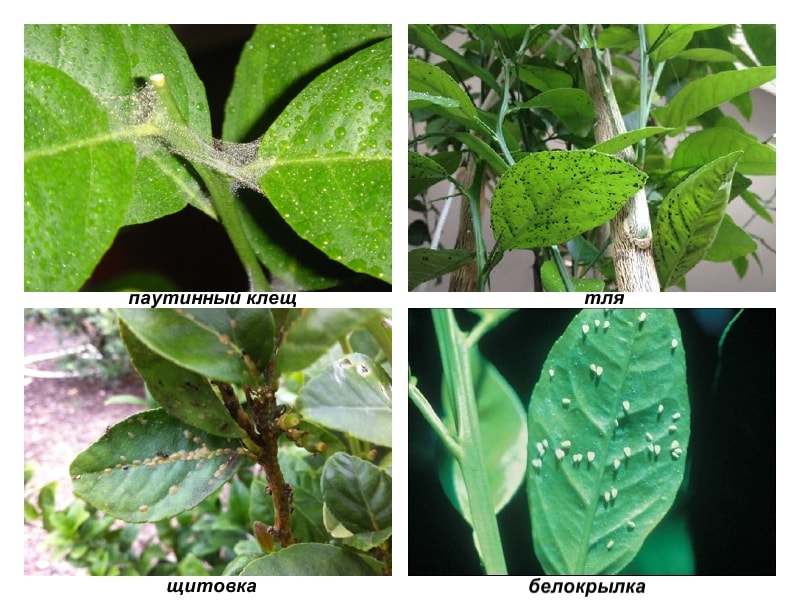
Thrips
Thrips are small pests that feed on lemon juice. Both adult black individuals and translucent larvae are dangerous for plants.
Symptoms of thrips damage:
- smudges of gray and silvery shade appear on the leaves;
- leaf plates are covered with light dots, brighten and fall off;
- inflorescences are deformed, spots appear on them;
- if you look closely, small elongated black and transparent insects become noticeable.
They fight thrips with insecticides or folk methods. The first method allows you to quickly get rid of the pest, but it is dangerous for humans and the environment. The second option is safer, but the treatment lasts longer.
How to get rid of lemon thrips:
- Infusion of soap and tobacco. 40 g of tobacco is poured into 1 liter of boiling water and insisted for three days. Filter the infusion and dissolve one fifth of a bar of soap in it. The resulting composition is sprayed on a tree. After a day, the product is washed off. The treatment is repeated after two days.
- Mustard infusion. 35 g of mustard are dissolved in 9.5 liters of water. The mixture is infused for three days. Before use, it is diluted with three parts of water. Used to spray plants.
Aphid
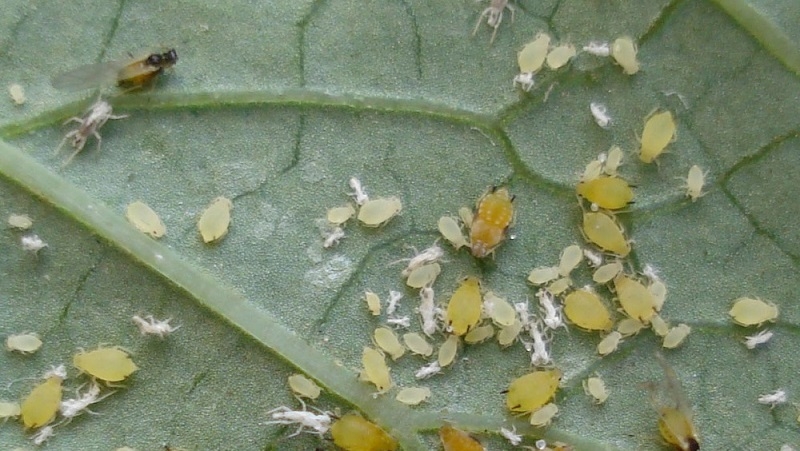
Aphids feed on the sap of leaves and young shoots. It is a light green insect no more than 3 mm in size.
The pest multiplies rapidly, affecting all parts of the plant. Without timely treatment, the tree dries up quickly.
When aphids are affected, the leaves of the plant turn pale and dry out. The ends of the shoots fade. It is not difficult to notice the insect, since it settles in large colonies.
To remove the pest of homemade lemon, use the following recipes:
- Soap solution. In 5 liters of water, dissolve half a piece of grated laundry soap. The product is used to wash the affected areas until the insects disappear completely (at least three times).
- Garlic infusion. A large head of garlic is poured into 0.5 liters of warm water and infused for three days. The infusion is filtered and used for spraying lemon.The procedure is carried out every other day for a week, then repeated every other week.
- Salt solution. Dissolve 150 g of salt in 2 liters of water. The tree is sprayed with the tool three times at intervals of a week.
Shield
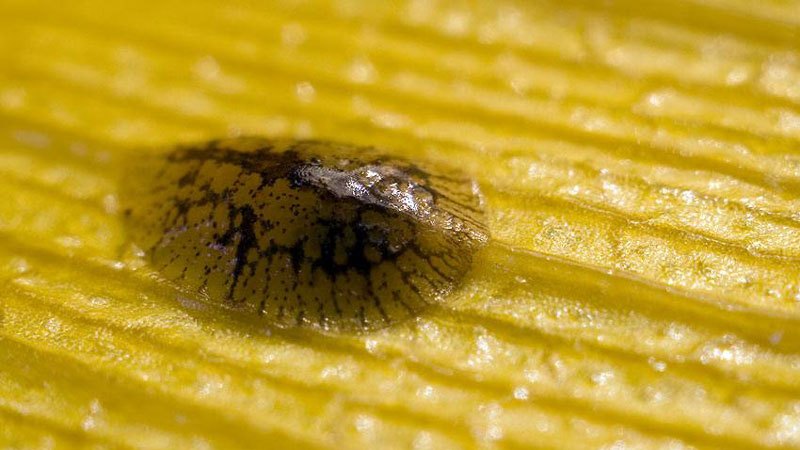
The scale insect is one of the most dangerous pests that parasitize lemon. The larvae stick to shoots and leaves, and then become covered with a dense shell.
Scabbards feed on plant sap. Their presence leads to drying out of leaves and shoots. Gradually, the plant dies.
The scabs look like convex oval or round formations up to 4 mm long. Depending on the type, they are yellow, brown, black. On the shells of some larvae there are patterns and specks.
Note! The hardest to spot is the yellow and light brown scale insects that are invisible on the leaves.
The scale insects are found not only on the shoots, but also on the veins on the inside of the leaf plates. The first sign of lemon damage by this pest is considered to be sticky yellowish spots on the leaves, which in consistency resemble honey or thick syrup.
A wax shield around the larvae protects them from the effects of certain poisons. Unlike many other pests, they cannot be washed off with plain water.
Gardeners prefer to fight the pest with the following methods:
- The most effective method of dealing with scabies is the use of insecticides (Fitoverm, Aktara)... The funds are absorbed into the plant, making its juice poisonous to the larvae. They spray the tree three to five times at intervals of two weeks. After that, the top layer of soil is removed and replaced with a new one. Lemon is washed in the shower. Fruits that appeared in the year of insecticide treatment are not eaten.
- Anabazine sulfate with soap. To prepare the product, 10 g of soap and 4 g of anabasine sulfate are dissolved in 2 liters of water. All parts of asthenia are wiped with the resulting solution, paying particular attention to convex formations. A day after treatment, the preparation is washed off with warm water together with the dead larvae. Processing is carried out every seven days for a month.
- Kerosene with soap... 10 g of grated soap and 20 g of kerosene are dissolved in 2 liters of warm water. The composition is sprayed with lemon every four days for a month.
Spider mite
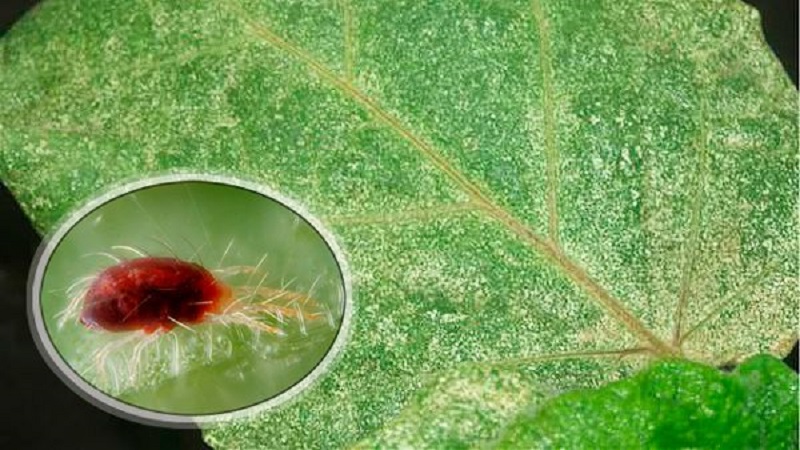
Spider mite is one of the most common lemon pestsgrowing at home. It enters the pot through an open window or contaminated soil.
The pest consists of small mites no more than 2 mm in size. Depending on the species, they can be red, black, transparent, orange, yellow and white.
Note! Indoor lemons usually have a red spider mite.
The pest feeds on the juice of young shoots and leaves. This leads to drying of leaf plates and shoots. The plant stops development and dies. In addition to direct harm, the insect carries viral infections.
A tick is recognized by the following features:
- A cobweb appears on the underside of the leaves. Small insects are visible in it.
- Light yellow dots appear on the leaf plates. These are puncture sites.
- The leaves turn yellow and dry out. They often roll up into a tube.
Despite the fact that the spider mite is a dangerous pest, it is not difficult to deal with it. In advanced cases, insecticides are used, but more often it is possible to do with folk remedies:
- Soap solution... Dissolve half a bar of laundry soap in 5 liters of water. Lemon and the soil around it are abundantly sprayed with the product twice a week until the problem disappears completely.
- Alcohol solution (96%) rub lemon leaves. If you take a lower concentration, the alcohol will evaporate for a long time, which will lead to burns on the leaves.
- Ultraviolet... A pot of lemon is placed under a UV lamp for two minutes. The procedure is carried out every other day. It is absolutely harmless to the plant, but destructive to the tick.
- Sulfaride paste (colloidal sulfur) 35%.The tree is treated with the tool at intervals of two weeks. It is not recommended to use the drug at the stage of flowering and fruit formation.
Mealybug
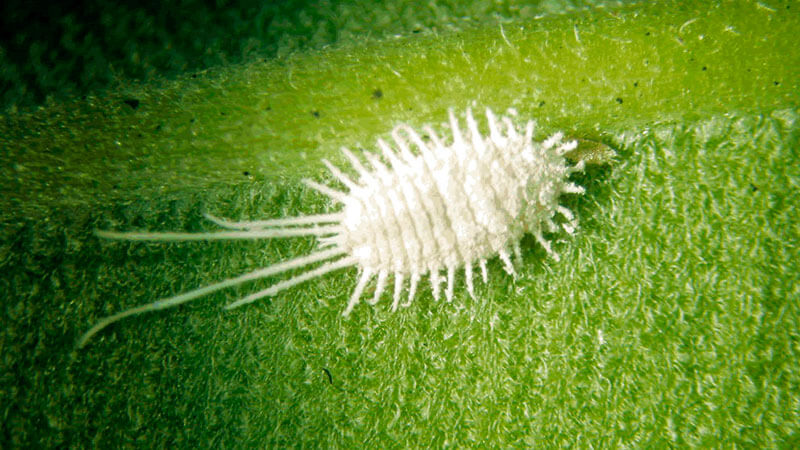
Mealybug is a small white pest not exceeding 6 mm in size. It feeds on the sap of the roots, leaves, buds and shoots of the plant, leading to its drying out and death.
A symptom of a pest is the appearance of a white fluffy bloom and sugary discharge. You need to treat lemon in the following ways:
- Insecticides ("Karbofos", "Decis"). Lemon is sprayed with means with an interval of two weeks.
- Infusion of garlic with soap... Three heads of chopped garlic are insisted in 2 liters of water for three days. Then the infusion is filtered and 20 g of soap is dissolved in it. The tree is sprayed every three days for a month.
- A mixture of soap, alcohol and tobacco. In a liter of water, 40 g of tobacco extract, 100 g of denatured alcohol and 100 g of grated laundry soap are dissolved. The plant is sprayed with the drug every week for a month.
Causes of diseases and their treatment at home
Sometimes citrus fruits become infected with fungal and viral infections. At home, this happens for the following reasons:
- pests:
- stagnant fluid;
- high or low humidity;
- cold air;
- contaminated soil and planting material;
- non-compliance with watering rules;
- proximity to infected plants;
- lack of nutrients.
Gommoz
Hommosis is a fungal disease. It is also called gum flow. The symptoms of the disease look like this:
- longitudinal brown spots appear on the trunk and branches;
- the bark in the affected areas dies and cracks;
- a golden liquid called gum starts to flow from the cracks.
The development of the fungus provokes a number of factors:
- deepening of the root collar during planting;
- stagnant moisture;
- excess nitrogenous fertilizers.
To save the plant, the affected areas are cut out and covered with a thick layer of garden varnish. The tree is sprayed with a solution of copper sulfate.
Mosaic
Mosaic is a viral disease. Spread by insects and wind. The leaves of the affected plants are covered with light spots, which are located mainly along the plate.
The disease does not respond to treatment. The affected tree will have to be destroyed.
It is interesting:
Anthracnose
Anthracnose is another disease that is flexible. It is activated at high soil or air humidity and low temperatures. Deficiency of phosphorus and calcium contributes to the development of infection.
On the leaves of a diseased plant, round brown spots are formed with well-defined, slightly convex edges. Then the spots move on to leaves and fruits.
Before treating the disease, the diseased parts of the plant are cut off. The tree is sprayed with a fungicide, such as Topaz.
Attention! Fungicides are poisonous to humans. It is important that they do not get onto dishes and food. The fruits of plants that have been processed during and after flowering are not eaten.
Scab
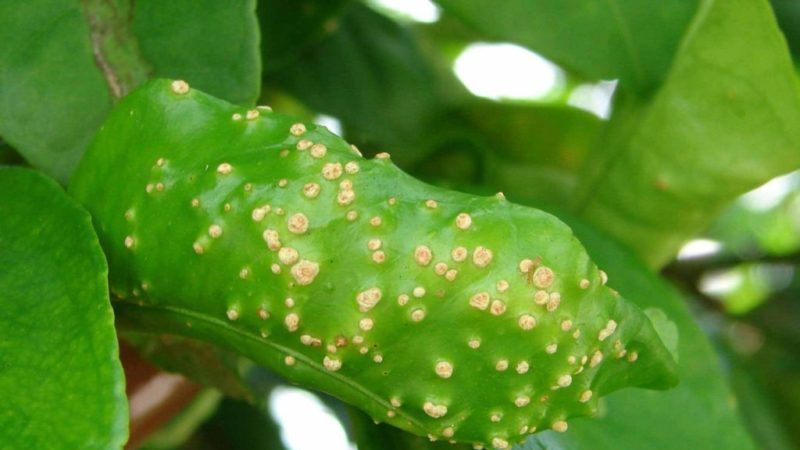
The scab is caused by a fungal infection. It causes the leaves, shoots and fruits of the lemon to fall off.
With the development of the disease, small pinkish or brown warts appear on the underside of the leaf plate. At their top there is a depressed section, in which the bend is located. From the leaves, the infection spreads to fruits and shoots. All affected parts are dropped.
To save the lemon tree, all infected parts are ripped off. Places of cuttings of shoots are smeared with garden pitch. The plant is sprayed with a solution of 1 tsp. copper sulfate and 3 liters of water.
Sooty fungus
The sooty fungus in the later stages of development covers all parts of the plant. This leads to disruption of photosynthesis, arrest of development and death of the lemon.
The reasons for the appearance of the disease are as follows:
- waste products of pests on leaves and shoots;
- high humidity in the room;
- violation of the temperature regime.
When infected, small patches of black plaque appear on the leaves. They gradually increase in size and cover the entire plate. The infection spreads to fruits and shoots.
To cure the disease, wipe the affected areas with a damp cloth. After that, they are treated with a biological preparation, for example, "Fitosporin". They spray the ground part of the plant and water the soil in a pot.
Root rot
Root rot is a fungal infection that attacks the roots. It is difficult to notice it at the beginning of the infection. The first signs appear when the ground part of the plant withers.
Root rot occurs due to buried planting, improper transplantation, watering with cold water and waterlogging of the soil.
A number of measures are taken to treat it:
- The plant is dug up and washed from the ground. The roots are examined for damage, the damaged areas are cut off.
- The roots are soaked for half an hour in a solution of potassium permanganate, then the cut sites are covered with garden varnish. For several hours, the lemon is soaked in a rooting stimulator.
- The plant is transplanted into disinfected soil.
Cancer
Citrus cancer is a viral disease. It is spread by pests and wind. Plants with a weakened immune system are most vulnerable to it.
Citrus Cancer Symptoms:
- small red round spots with a yellow border appear on the leaves;
- soon formations pass to shoots and fruits;
- spots blur, increase in size;
- the plant dries up.
The disease is not treatable. The infected lemon dies. So that it does not infect other plants, it is eliminated at the initial stage of the development of the disease.
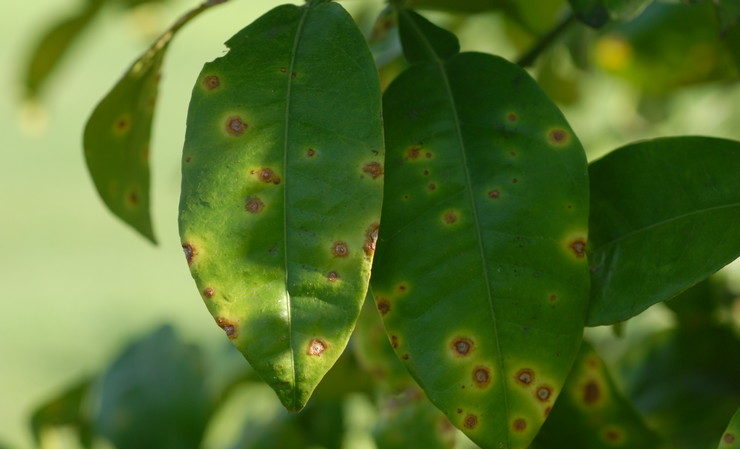
Prevention of diseases and pests of indoor lemon
Diseases are easier to prevent than to cure. Indeed, even in case of successful healing, the lemon will remain weakened for a long time.
Prevention includes the following items:
- compliance with watering rules;
- maintaining optimal air humidity;
- timely pest control;
- disinfection of garden tools, soil and planting material;
- compliance with the temperature regime;
- making enough top dressing;
- transplanting into disinfected soil and preventive treatment of new plants;
- weekly preventive examinations;
- weekly washing the plant in the shower;
- sanitary pruning.
Conclusion
Diseases and pests are the main cause of the death of indoor lemon. Fungi, viruses and insects parasitize the plant, leading to the loss of leaves, inflorescences, fruits and shoots, impairment of photosynthesis, and decreased endurance.
The sooner the treatment begins, the more chances you have to save the tree. Therefore, it is so important to know the symptoms of various diseases and how to treat them.